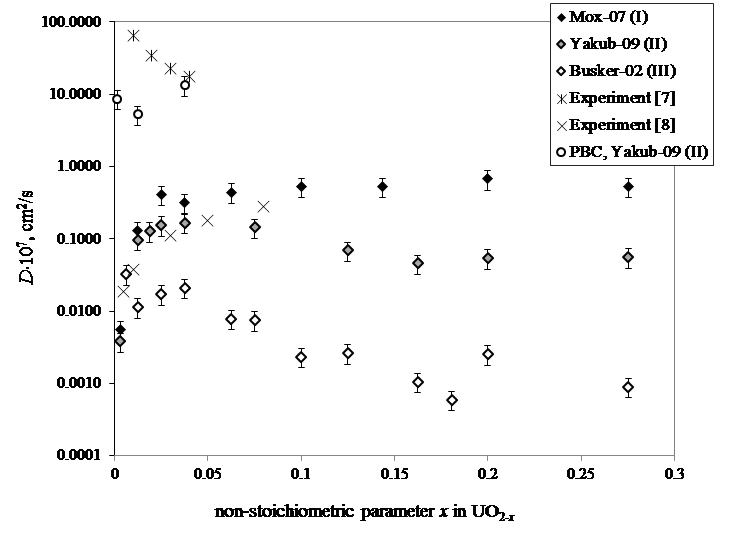
Diffusion of oxygen in hypostoichiometric uranium dioxide nanocrystals. A molecular dynamics simulation
Abstract
Keywords
Full Text:
PDFReferences
Choi E-Y, Kim J-K, Im H-S, Choi I-K, Na S-H, Lee JW, Jeong SM, Hur J-M. Effect of the UO2 form on the electrochemical reduction rate in a LiCl–Li2O molten salt. J Nucl Mater. 2013;437:178–87. doi:10.1016/j.jnucmat.2013.01.306
Hur J-M, Hong S-S, Lee H. Electrochemical reduction of UO2 to U in a LiCl–KCl-Li2O molten salt. J Radioanal Nucl Chem. 2013;295:851–4. doi:10.1007/s10967-012-2258-0
Sakamura Y, Kurata M, Inoue T. Electrochemical reduction of UO2 in molten CaCl2 or LiCl. J Electrochem Soc. 2006;153(3):D31–9. doi:10.1149/1.2160430
Choi E-Y, Won CY, Cha J-S, Park W, Im HS, Hong SS, Hur J-M. Electrochemical reduction of UO2 in LiCl–Li2O molten salt using porous and nonporous anode shrouds. J Nucl Mater. 2014;444:261–9. doi:10.1016/j.jnucmat.2013.09.061
Willit JL, Miller WE, Battles JE. Electrorefining of uranium and plutonium - A literature review. J Nucl Mater. 1992;199:229-49. doi:10.1016/0022-3115(92)90515-M
Sakamura Y, Omori T. Electrolytic Reduction and Electrorefining of Uranium to Develop Pyrochemical Reprocessing of Oxide Fuels. Nuclear Technology. 2017;171(3):266-75. doi:10.13182/NT10-A10861
Bayoglu AS, Lorenzelli R. Oxygen diffusion in fcc fluorite type nonstoichiometric nuclear oxides MO2±x. Solid State Ionics. 1984;12:53–66. doi:10.1016/0167-2738(84)90130-9
Kim KC, Olander DR. Oxygen diffusion in UO2−x. J Nucl Mater. 1981;102:192–9. doi:10.1016/0022-3115(81)90559-6
Murch GE, Catlow CRA. Oxygen diffusion in UO2, ThO2 and PuO2. A Review. J Chem Soc, Faraday Trans 2. 1987;83:1157–69. doi:10.1039/F29878301157
Hayward PJ, George IM, Kaatz RA, Olander DR. Measurement of 2000–2100°C oxygen diffusion coefficients in hypostoichiometric UO2. J Nucl Mater. 1997;244:36–43. doi:10.1016/S0022-3115(96)00722-2
Moore E, Gueneau C, Crocombette J-P. Diffusion model of the non-stoichiometric uranium dioxide. J Solid State Chem. 2013;203:145–53. doi:10.1016/j.jssc.2013.04.006
Li Y, Liang T, Sinnott SB, Phillpot SR. A charge-optimized many-body potential for the U–UO2–O2 system. J Phys Condens Matter. 2013;25:505401. doi:10.1088/0953-8984/25/50/505401
Li Y. A fundamental understanding of the structures of oxygendefect clusters in UO2+x, U4O9 and U3O7: from the perspective of Tetris cubes. Acta Materialia. 2020;194:482–95. doi:10.1016/j.actamat.2020.05.032
Emre C, Govers K., Lamoen D, Labeau P-E, Verwerft M. Atomic scale analysis of defect clustering and predictions of their concentrations in UO2+x. J Nucl Mater. 2020;541:152403. doi:10.1016/j.jnucmat.2020.152403
Morelon N-D, Ghaleb D, Delaye J-M, Van Brutzel L. A new empirical potential for simulating the formation of defects and their mobility in uranium dioxide. Phil Mag. 2003;83:153355. doi:10.1080/1478643031000091454
Potashnikov SI, Boyarchenkov AS, Nekrasov KA, Kupryazhkin AY. High-precision molecular dynamics simulation of UO2–PuO2: Anion self-diffusion in UO2. J Nucl Mater. 2013;433:215-26. doi:10.1016/j.jnucmat.2012.08.033
Yakub E, Ronchi C, Staicu D. Computer simulation of defects formation and equilibrium in non-stoichiometric uranium dioxide. J Nucl Mater. 2009;389:119–26. doi:10.1016/j.jnucmat.2009.01.029
Govers K, Lemehov S, Hou M, Verwerft M. Molecular dynamics simulation of helium and oxygen diffusion in UO2±x. J Nucl Mater. 2009;395:1319. doi:10.1016/j.jnucmat.2009.10.043
Goel P, Choudhury N, Chaplot SL. Atomistic modeling of the vibrational and thermodynamic properties of uranium dioxide, UO2. J Nucl Mater. 377;2008:438. doi:10.1016/j.jnucmat.2008.03.020
Potashnikov SI, Boyarchenkov AS, Nekrasov KA, Kupryazhkin AY. High-precision molecular dynamics simulation of UO2–PuO2: Pair potentials comparison in UO2. J Nucl Mater. 2011;419:217–25. doi:10.1016/j.jnucmat.2011.08.033
Govers K, Lemehov S, Hou M, Verwerft M. Comparison of interatomic potentials for UO2: Part II: Molecular dynamics simulations. J Nucl Mater. 2008;376:66–77. doi:10.1016/j.jnucmat.2008.01.023
Balboa H, Van Brutzel L, Chartier A, Le Bouar Y. Assessment of empirical potential for MOX nuclear fuels and thermomechanical properties. J Nucl Mater. 2017;495:67–77. doi:10.1016/j.jnucmat.2017.07.067
Busker G, Ph.D. thesis, Imperial College, London; 2002.
Matzke H. Atomic Transport Properties in UO2 and Mixed Oxides (U, Pu)O2. J Chem Soc, Faraday Trans 2. 1987;83:1121-42. doi:10.1039/F29878301121
Berthinier C, Rado C, C. Chatillon C, Hodaj F. Thermodynamic assessment of oxygen diffusion in non-stoichiometric UO2±x from experimental data and Frenkel pair modeling. J Nucl Mater. 2013;433:265–86. doi:10.1016/j.jnucmat.2012.09.011
Basak CB, Sengupta AK, Kamath HS. Classical molecular dynamics simulation of UO2 to predict thermophysical properties. J Alloys Compd. 2003;360:210–6. doi:10.1016/S0925-8388(03)00350-5
Thermophysical properties database of materials for light water reactors and heavy water reactors, IAEA (2006). http://www.pub.iaea.org/MTCD/publications/PDF/te_1496_web.pdf
Nekrasov KA, Seitov DD, Pomosova AA, Kupryazhkin AY, Gupta SK, Usseinov AB. Sputtering of material from the surface of PuO2 crystals by collision cascades impact. A molecular dynamics study. Nuclear Instruments and Methods in Physics Research Section B: Beam Interactions with Materials and Atoms. 2020;475:39–43. doi:10.1016/j.nimb.2020.04.034
Seitov DD, Nekrasov KA, Kupryazhkin AY, Gupta SK, Usseinov AB. The impact of the collision cascades on the xenon and helium clusters in PuO2 crystals. A molecular dynamics simulation. A molecular dynamics study. Nuclear Instruments and Methods in Physics Research Section B: Beam Interactions with Materials and Atoms. 2020;476:26–31. doi:10.1016/j.nimb.2020.04.040
DOI: https://doi.org/10.15826/chimtech.2021.8.1.07
Copyright (c) 2021 Kirill A. Nekrasov, Alexander E. Galashev, Dastan D. Seitov, Sanjeev K. Gupta

This work is licensed under a Creative Commons Attribution 4.0 International License.
Chimica Techno Acta, 2014–2025
eISSN 2411-1414
Copyright Notice







